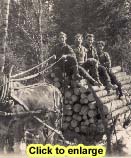 |
 |
| We
present here a list of sawmills that have existed in the region and that
are not associated with the four principal families discussed previously.
We present them in chronological order, according to the date of their
foundation.
It
must be noted that this list is not exhaustive. Several sources were consulted
to obtain this information; yet the following list probably remains incomplete.
-
MacEachern,
McMiphen (or McMechen), McNeil and Pellow sawmills: little is known about
these mills located in Hazel (Wyborn). Mr. Charles Duguay arrived in Wyborn
in 1915 and worked at Mr. McMechen’s mill (Mr. McMechen’s first name might
have been Georges). This sawmill was on the Mattawishkwia River shores.
In an interview with the Le Nord newspaper in 1990, Georges Dillon mentions
that Huey McNeal (or McNeil) had built two sawmills: one “stud mill” where
9-foot lumber was made and one regular sawmill. The first was located near
the railroad and the other near the McMechen mill.
-
Simmons
sawmill: located in McManusville (St-Pie-X), this sawmill was run in the
early 20s solely by its owner, Mr. Simmons (first name unknown).
-
Huard
sawmill: in 1923, Alphonse Huard built a sawmill near his house in the
Kendall Township (third concession), mill which he had shipped by train
from Plessiville, Québec. He sawed settlers’ timber with the help
of his sons.
-
Poliquin
sawmill: Achilles Poliquin installed this sawmill in 1924 in concessions
six and seven near Halléwood (Hallébourg), on Kendall creek
shores. He operated the mill himself with the help of his sons to supply
settlers with lumber. In 1929 the mill was acquired by Alfred Fortier and
closed a few years later (La Défriche, 1974 : 50).
|
 |
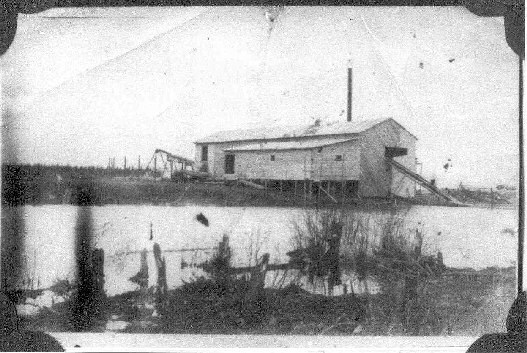
|
Poliquin
sawmill in Halléwood (Hallébourg)
(picture
donated by Mr. Raymond Brochu)
|
 |
-
Doucet
sawmill: around 1924, until the 30s, Alfred (Joseph) Doucet operated a
sawmill in Stavert (Jogues) with the help of his sons. The mill was located
near the railroad. Father Zoël Lambert told the Le Nord newspaper
that trees were rafted on a nearby stream to supply the mill with timber.
The mill was sold to Adélard Haman in the 1930s.
|
 |
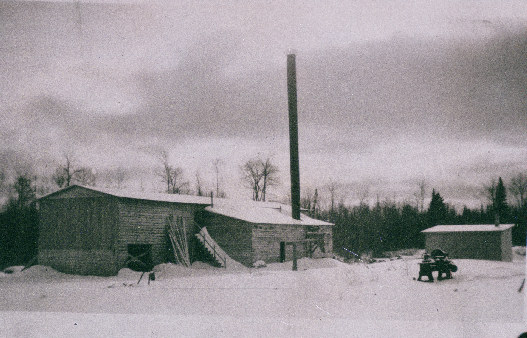
|
Doucet
sawmill in Jogues
(Société
historique collection; picture donated by the Hearst Bishopric)
|
 |
-
Veilleux
Brothers sawmill: around 1930, four Veilleux brothers (Georges, Alphonse,
Stanislas and Philippe) built a sawmill at Pivabiska Lake to provide settlers
with lumber. Timber for the mill came from their land and also from their
other brother Godfroy's land. The sawmill was destroyed by a fire in 1935
and was never rebuilt. One of the brothers, Alphonse, salvaged the equipment
and installed a new mill on his property.
-
Joseph
Buteau sawmill: Starting in 1924, Joseph Buteau and his sons Gédéon
and Philippe operated a portable sawmill on lot 24, concession four of
Eilber Township. The mill was moved to Shallow Lake, and later to the tenth
concession east of Missinaïbi River and, finally, on the river’s shores
near lot 27 of Eilber Township’s third concession (Si Missinaïbi m’était
contée…Tome 1, 1986 : 82).
-
Philippe
Buteau sawmill: In the 1940s, Philippe Buteau operated a sawmill near the
Nagagami River for the Marathon Paper Mills company. He moved the mill
to Hornepayne. Philippe Buteau also built sawmills for other people.
-
Dupuis
sawmill: in 1924, Cléophas Dupuis installed a sawmill on Missinaïbi
River shores in Mattice (on the south side of the bridge). Mr. Dupuis previously
operated the sawmill in Sainte.Lucie, Québec, and transported it
by train to Mattice. His brother Bernard and his sons Albert and Armand
helped him in his endeavour. After their father’s death in 1939, Albert
and Armand took charge of the mill and created Dupuis Lumber. They moved
the sawmill to Shallow Lake. In 1945, Albert became the company’s sole
owner and moved the operations back to Mattice and attempted to increase
sales. In 1949, he moved the mill to the Nagagami River where he and his
son Emmanuel processed Marathon Paper Mills’ timber. After one winter,
Albert Dupuis brought the sawmill back to Mattice. He processed timber
from contractors like Pierre-Paul Vaillancourt and wood he obtained from
permits granted by settlers. Having failed to obtain a logging licence
on Crown lands, he was forced to cease operations during the 60s (Si Missinaïbi
m’était contée…Tome 1, 1986 : 82).
|
 |
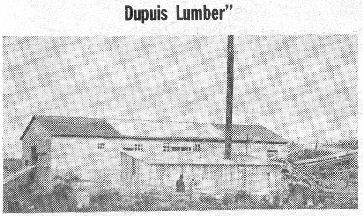
|
Dupuis
sawmill in Mattice.
(picture
donated by the Le Nord newspaper)
|
 |
-
Charpentier
sawmill: Fred Charpentier owned and operated a sawmill at Lac Sainte.Thérèse
during the 1930s. He produced lumber for settlers.
-
Saulnier
sawmill: during the 1930s, Félix Saulnier owned and operated a portable
sawmill seven miles south-west of Val Côté.
 |
-
Bolduc
sawmill at French Lake (1934-1946): The Bolduc family (Archelas the father
and his sons Napoléon, Désiré, Edmond, Herménégylde,
Gustave and Alfred) owned and operated a mill north of Ryland and south
of Noé Fontaine’s mill. The family
harvested timber on its lands and got more from settlers. The lumber produced
by the mill was sold notably to Guénette of Kapuskasing and southern
buyers. The sawmill was reportedly sold to Mr. Boisvert and Mr. Croteau
of Abitibi in around 1944. Mr. Évariste Proulx worked several months
in the Bolduc mill, probably in 1935, at the age of 18. “I worked the night
shift. The mill worked 24 hours a day and we only took ten-minute breaks
every six hours to grease up. We had to ‘clear the slip’ during 12 hours,
rain or shine” (Excerpt from an interview by the Société
historique, 1986).
|
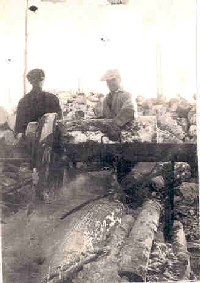
Bolduc
sawmill
Left
to right: Gustave and Edmond Bolduc (picture donated by Mrs. Aline Bolduc)
|

|
-
Haman
and Canada Forwarding sawmills at Carey Lake (1935-1948): during the 1930s,
Adélard Haman purchased the Doucet sawmill in Jogues and operated
it at the same location for some time, with the help of family members.
In 1938, Mr. Haman was granted logging rights in the Stoddart Township
and moved the mill to Carey Lake. In the mid-40s, he sold the mill to American
company Canada Forwarding, which operated the mill until 1948.
-
Forcier
sawmill (1945,1947): in the mid-1940s Clément Forcier built a sawmill
at Lac Sainte.Thérèse to supply settlers with lumber. These
settlers brought timber to the mill to get it sawed. A tractor engine activated
the mill, which only functioned during the spring.
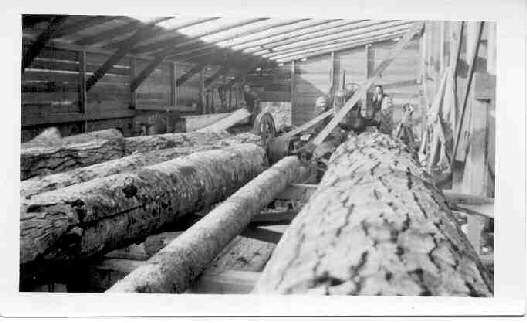
|
Forcier
sawmill at Lac Sainte.Thérèse
Notice
in the background the tractor which runs the mill
(picture
donated by Mrs. Jeanne Forcier)
|
-
Létourneau
sawmill at Kabina River (1945-1948): Willie Létourneau purchased
this sawmill from Noé Fontaine in
1945. The Transcontinental Timber company sent wood to the mill on the
Kabina River. In 1948, Mr. Létourneau sold the Kabina River sawmill
to J. D. Levesque, who had already bought
a planer owned by Willie’s brother Raoul.
-
Odilon
Payeur and Joseph Vaillancourt sawmill in Coppell (1946-1952): shortly
after Odilon Payeur installed a sawmill in Coppell in 1946, Joseph Vaillancourt
joined him from the V. & P. company. The company hired dozens of workers
during its operation.
-
Boisvert
sawmill at Forde Lake (1948-1949): Aristide and Camille Boisvert operated
a sawmill during one winter near Forde Lake. It is speculated that the
Boisverts would have purchased the Bolduc mill and moved it to this location.
-
Timber
Product sawmill (1949-1955): a Montréal businessman named Alex Bruun
owned this sawmill located near the entrance to the road leading to the
Henry
Selin Forest Products mill.
-
Lallier
sawmill (1950-1952): in the early 1950s, Fred Lallier operated a sawmill
near the intersection of Highway 11 and the road leading to Hornepayne
(Palmquist), sawing for the Marathon Paper Mills company.
-
Henri-Louis
Gosselin sawmills (1950-1957): Henri-Louis Gosselin operated a sawmill
for the Marathon Paper Mills company at Rabbit Lake’s principal camp. Mr.
Gosselin moved the mill to Elof Christianson’s logging lands, north of
Mattice, in 1952. Mr. Gosselin employed a dozen workers and was paid by
Elof Christianson’s company, Spruce Land Forest Products, for each thousand
feet of wood he sawed, the product of which was sold to southern wholesalers.
Mr. Gosselin took his mill apart in 1956 or 1957; Mr. Christianson
then installed his own sawmill, which functioned for a few years before
burning to the ground. It was never rebuilt. Mr. Christianson was mainly
a pulpwood contractor for the Spruce Falls Power and Paper Company.
-
Spruce
Dale Lumber sawmill in Mattice (1971-1974): Elof Christianson succumbed
to a heart attack in 1970 while he was on a train to Toronto. He was on
his way to Sweden to check out equipment for a new sawmill in Mattice.
The sawmill was nevertheless installed west of the Missinaïbi River
bridge by his sons Ted and Don and their cousin Allan Edlund. The Spruce
Dale Lumber sawmill functioned from 1971 to 1974, when it was sold to Levesque
Lumber of Hearst, along with its logging lands.
|
 |
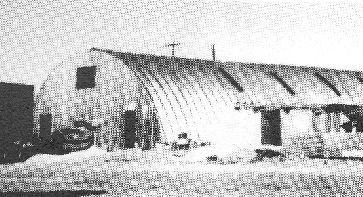
|
Spruce
Dale Lumber sawmill in Mattice.
(picture
donated by the Mattice-Val Côté municipality)
|
 |
-
Newaygo
sawmill in Mead (1973-1984): Newaygo Timber, an American company, established
a sawmill in Mead in 1973 for an estimated cost of
$5
million. The mill was operational until 1984.
|

 |
 |
 |
 |
